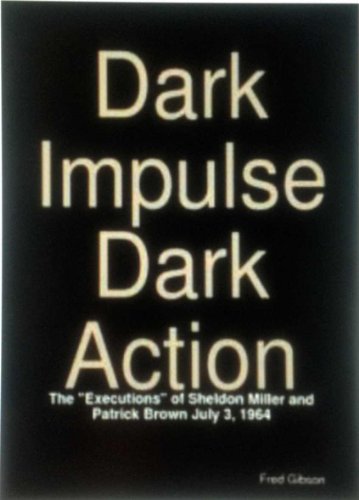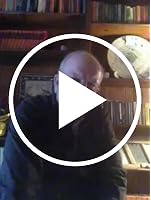Detroit Metropolitan Police investigated the 3 July 1964 murder of Francis Patrick Brown, 17 and Sheldon Robert Miller, 14. The investigation involved almost the entire department from the Police Commissioner on down at the very start. By 14 February 1965 after an extensive investigation, the case was still unsolved and only three investigators were still assigned to it.
Crime Scene: The Robert C. Milan Memorial Playfield, a 12 acre field, adjacent to and west of Emerson School on Huntington Ave. The playfield is bordered by Curtis to the south and Pickford to the North. The westernmost end of the field is just past Plainview.
Overhead photos of the Crime Scene were taken and published in the 12 July 1964 edition of the Detroit News, along with annotated positions of where the bodies were located, where various evidence was found, and where certain witnesses stood.
Detroit Police investigators determined that about 28 persons, most of them teenagers, were in the Milan Playfield around the time of the shootings.
Witnesses:
Here are the names and 1964 addresses of some witnesses as reported in the Detroit News articles:
- Linda Miller, 17, sister of Sheldon Miller. She was with her brother most of the evening until he met up with his friend Pat Brown in the playfield some time shortly after 10 PM. She watched the boys set off a few firecrackers and then left them to go to the Miller home.
- David Charles Budson, 16, discovered the bodies at 12:05 AM 4 July 1964 while out walking a dog. He lived at 19275 Cooley. David later attended the University of Michigan and became a Medical Doctor. He died at age 63 in Berkeley, California.
- Arthur Waldman, 16, was with Budson when they found the two bodies. He lived at 19923 Cooley. Both he and Budson were students at Cass Tech High School. Arthur also later studied medicine at the University of Michigan, and currently practices medicine in Wisconsin.
- Thomas Termini, 16, of 18554 Plainview, was in the playfield with friend Linda Johnson, when they encountered both Pat and Sheldon. Thomas spoke with Pat, whom he knew, for a few minutes and then he and Linda left them to cut across the playfield. Thomas could still hear Pat's voice across the playfield when he heard what he described as " a number of explosions - five, six, or seven of them in a row". He attached no importance to them at the time.
About the same time that Thomas Termini heard the explosions, he and Linda were walking by a house at Anchester and Pickford, when they heard something bounce against what he thought was the house. Later investigators found a .22 slug embedded in a telephone pole near the house.
- Linda Johnson, 15, of 18900 Plainview, spoke with Sheldon briefly and learned that the boys had just purchased some firecrackers. She was with Thomas Termini that evening. Thomas and Linda were possibly the last witnesses to see Pat and Sheldon alive.
- Mrs. James Ross of 18400 Huntington, stated that there were a lot of boys in the playground that night as well as two cars.
- Louis Kanaras of 18400 Edinborough, stated that there were a lot of firecrackers going off, but heard what he thought might have been a quick succession of six shots fired at about 10:30 PM.
- Two boys (unnamed in News reports) ages 19 and 15 stated that they had sold two packets of 16 firecrackers each to Pat and one packet to Sheldon. They may have been closest to the scene of the shooting. One packet of firecrackers was found with Patrick Brown, and one packet of firecrackers was found with Sheldon Miller.
- A boy, age 17 (unnamed in News accounts), claimed to have seen an older teenager or young man, large in size, about 6 feet tall, heavyset leaving the area of the shooting at about 10:45 PM. He said that he did not know the man's name, but ran from him because he believed he recognized him as a "bully" that he had encountered on the playfield before.
- Richard Brown, 20, brother of Francis Patrick Brown, was home on leave from the Coast Guard. He heard the police sirens and saw the night time activity of the homicide investigation. In the morning, police took him to the site of the murder to see where his brother had been killed.
Detroit Police investigators developed a detailed chronology of locations and person contacts for Francis Patrick "Pat" Brown in the hours leading up to his murder. They had a somewhat less detailed chronology for Sheldon Miller because he had spent most of the evening at home with his family. No motive or solid suspect was ever determined for what seemed a senseless and brutal killing of the two boys.
The initial reports mentioned as a possible suspect, a large, heavy set man who might have been over six feet tall. That description came from a 17 year old boy (unnamed in News reports).
Days later, that 17 year -old boy tentatively picked out a 22 year-old man in a police lineup, as possibly the person he had seen. However, the person he picked out (also not named in News reports) was considered NOT a suspect due to an alibi: he was being questioned by Dearborn police on another matter at 11PM the night of the shootings.
Crime Scene: The Robert C. Milan Memorial Playfield, a 12 acre field, adjacent to and west of Emerson School on Huntington Ave. The playfield is bordered by Curtis to the south and Pickford to the North. The westernmost end of the field is just past Plainview.
Overhead photos of the Crime Scene were taken and published in the 12 July 1964 edition of the Detroit News, along with annotated positions of where the bodies were located, where various evidence was found, and where certain witnesses stood.
Detroit Police investigators determined that about 28 persons, most of them teenagers, were in the Milan Playfield around the time of the shootings.
Witnesses:
Here are the names and 1964 addresses of some witnesses as reported in the Detroit News articles:
- Linda Miller, 17, sister of Sheldon Miller. She was with her brother most of the evening until he met up with his friend Pat Brown in the playfield some time shortly after 10 PM. She watched the boys set off a few firecrackers and then left them to go to the Miller home.
- David Charles Budson, 16, discovered the bodies at 12:05 AM 4 July 1964 while out walking a dog. He lived at 19275 Cooley. David later attended the University of Michigan and became a Medical Doctor. He died at age 63 in Berkeley, California.
- Arthur Waldman, 16, was with Budson when they found the two bodies. He lived at 19923 Cooley. Both he and Budson were students at Cass Tech High School. Arthur also later studied medicine at the University of Michigan, and currently practices medicine in Wisconsin.
- Thomas Termini, 16, of 18554 Plainview, was in the playfield with friend Linda Johnson, when they encountered both Pat and Sheldon. Thomas spoke with Pat, whom he knew, for a few minutes and then he and Linda left them to cut across the playfield. Thomas could still hear Pat's voice across the playfield when he heard what he described as " a number of explosions - five, six, or seven of them in a row". He attached no importance to them at the time.
About the same time that Thomas Termini heard the explosions, he and Linda were walking by a house at Anchester and Pickford, when they heard something bounce against what he thought was the house. Later investigators found a .22 slug embedded in a telephone pole near the house.
- Linda Johnson, 15, of 18900 Plainview, spoke with Sheldon briefly and learned that the boys had just purchased some firecrackers. She was with Thomas Termini that evening. Thomas and Linda were possibly the last witnesses to see Pat and Sheldon alive.
- Mrs. James Ross of 18400 Huntington, stated that there were a lot of boys in the playground that night as well as two cars.
- Louis Kanaras of 18400 Edinborough, stated that there were a lot of firecrackers going off, but heard what he thought might have been a quick succession of six shots fired at about 10:30 PM.
- Two boys (unnamed in News reports) ages 19 and 15 stated that they had sold two packets of 16 firecrackers each to Pat and one packet to Sheldon. They may have been closest to the scene of the shooting. One packet of firecrackers was found with Patrick Brown, and one packet of firecrackers was found with Sheldon Miller.
- A boy, age 17 (unnamed in News accounts), claimed to have seen an older teenager or young man, large in size, about 6 feet tall, heavyset leaving the area of the shooting at about 10:45 PM. He said that he did not know the man's name, but ran from him because he believed he recognized him as a "bully" that he had encountered on the playfield before.
- Richard Brown, 20, brother of Francis Patrick Brown, was home on leave from the Coast Guard. He heard the police sirens and saw the night time activity of the homicide investigation. In the morning, police took him to the site of the murder to see where his brother had been killed.
Detroit Police investigators developed a detailed chronology of locations and person contacts for Francis Patrick "Pat" Brown in the hours leading up to his murder. They had a somewhat less detailed chronology for Sheldon Miller because he had spent most of the evening at home with his family. No motive or solid suspect was ever determined for what seemed a senseless and brutal killing of the two boys.
The initial reports mentioned as a possible suspect, a large, heavy set man who might have been over six feet tall. That description came from a 17 year old boy (unnamed in News reports).
Days later, that 17 year -old boy tentatively picked out a 22 year-old man in a police lineup, as possibly the person he had seen. However, the person he picked out (also not named in News reports) was considered NOT a suspect due to an alibi: he was being questioned by Dearborn police on another matter at 11PM the night of the shootings.
Last edited:


